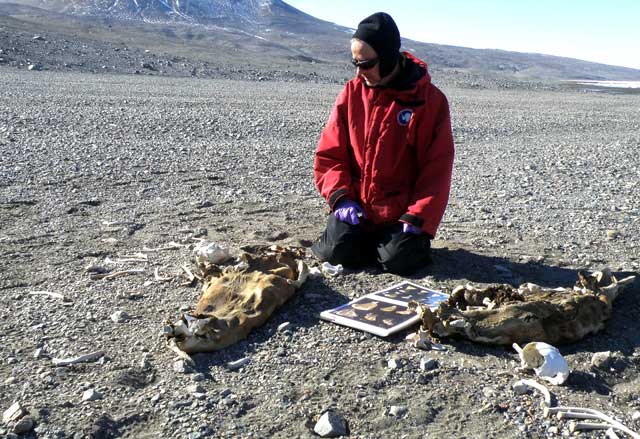|
Valley of the dead ... sealsRemote mummified remains tell story about past ecology and climate changePosted February 28, 2014
Antarctica has existed in a deep freeze for millions of years. But even the world’s coldest continent isn’t as unyielding as it might seem. Ice sheets shrink and expand over time, as does the sea ice that encircles Antarctica. These variations in the ice cover signal changes in the climate or environmental conditions, such as fluctuations in ocean circulation. Scientists use a standard suite of methods to measure and interpret such changes, from collecting ice and sediment cores to making observations with GPS and satellites. And then there is the team hunting for mummified seals in the McMurdo Dry Valleys “We’re looking for two things: Changes in the ecology of the species and changes in the ecosystem. Sometimes we’re using the seals as sampling buoys. Sometimes we’re actually trying to figure out what they’re doing,” explained Paul Koch 
Photo Courtesy: Paul Koch
Scientist Paul Koch sorts out the bones of three seal mummies at New Harbor.
Koch and co-principal investigator Brenda Hall Each year they’ve collected small samples of fur, skin, bone, whisker and even bits of teeth from long-dead seals that had somehow wormed their way many kilometers inland from the cold waters of McMurdo Sound and the Ross Sea. Hall, Koch, and colleagues had previously focused on the presence of numerous mummified elephant seals along the beaches of Victoria Land. The discovery of major colonies so far south suggested that milder climate conditions existed between 7,000 and 1,000 years ago before the population declined and went locally extinct about 400 years ago – a finding that was published in 2009 in the journal PLoS Genetics. [See previous article — Cradle to grave: Study provides insight into evolution and extinction of vanished elephant seal colony.] Today, extensive sea ice and land fast ice exists along the 300-kilometer-long coast where, at its height, the elephant seal population included more than 220,000 individuals based on DNA evidence recovered mainly from fur and skin. While some elephant seals feed in sea ice, they will not travel across ice shelves, meaning that ice-free conditions must have existed that allowed the animals to access the Victoria Land beaches during the part of the year when they would normally come ashore to breed and molt. Then the climate appeared to shift to a colder and icier regime about a thousand years ago. Koch, Hall and their team are now shifting their focus inland to the valleys where for reasons still unknown, some species of seals – crabeater, Weddell and leopard – have wandered. Their mummified remains may offer clues about the changes in environmental conditions that occurred a thousand years ago, as well details about the past ecology of these animals – and their prospects for the future. “This research was largely spurred by that elephant seal project,” Koch said. “It was pretty clear that the disappearance of the elephant seals signaled an environmental change.” Added Hall, the paleoclimate expert, “It might also suggest that what we think of as normal today might only have come into existence in the last thousand years or so ago.” The researchers, including postdocs, graduate students and undergraduates, spent about a month each year in field camps in the McMurdo Dry Valleys, where this season they collected specimens from about 200 crabeater seals, 50 Weddell seals and 10 leopard seals – a proportion that somewhat corresponds to the existing populations today. Koch said many of the mummified seals had been assumed to be crabeater seals (Lobodon carcinophaga), the most populous seal today and one of the most abundant wild large mammals on Earth. They prefer the seasonal pack ice as a habitat versus Weddell seals (Leptonychotes weddellii), which are more comfortable in thicker sea ice attached to the shore. “For these seals here now, the big change would be the presence or absence of the land-fast ice,” Koch noted. Were crabeaters even more populous when the elephant seal colonies were thriving during the period when less ice was present between 7,000 and 1,000 years ago? What would happen to them in the future should such conditions return? “[Crabeater seals are] a big chunk of the ecosystem. Understanding how they respond to this perturbation is very important,” Koch said. “They’re a key player. They’re the ones I’m most interested in.” The third pinniped under study, the solitary leopard seal (Hydrurga leptonyx), is a formidable predator that keeps the crabeater population in check, eating about 80 percent of them. Little is known about their ecology. “They’re much easier [to study] dead than alive,” Hall quipped. |
"News about the USAP, the Ice, and the People"



For USAP Participants |
For The Public |
For Researchers and EducatorsContact UsNational Science FoundationOffice of Polar Programs Geosciences Directorate 2415 Eisenhower Avenue, Suite W7100 Alexandria, VA 22314 Sign up for the NSF Office of Polar Programs newsletter and events. Feedback Form |



